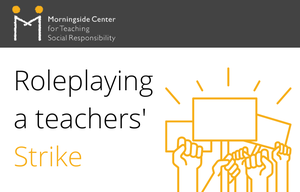
In Focus
Teachers' Strikes
By Callum Mason, Reboot the Future
Why this topic matters
Whether or not you are one of the more than 100,000 teachers who are planning on striking in the UK this week, it is important to be able to talk to your students about what is happening and why many teachers feel it is necessary to take this step.
Strikes are intentionally disruptive, which can be particularly challenging when you work in a caring profession. By building context, developing compassionate outlooks, and communicating clearly, you can help your learners to feel secure, aware, and engaged in this issue.
Connections to the curriculum
- History: Learn about the history of the labour movement, why it formed, and what it has achieved.
- English: Write a short story that explores the emotions of someone considering whether to strike or not.
- PSHE: Explore workers’ rights, the responsibilities of school management, and the dilemmas of policy makers.
- Drama: Use the Morningside Centre’s resource to roleplay a teachers' strike and its various possible outcomes.
- Maths: Calculate how the average wage has kept up with inflation over time.
How to approach it
Learn: Explore why unions formed and what they have achieved
With this sometimes controversial topic it’s important to cut through disinformation with some simple context behind the formation and working of unions. Here, the Working Class Movement Library has some useful resources that explain many of the reasons why British industrial workers began to unionise. It’s also hugely important to explain what unions have actually achieved both at home and abroad. For example, unions have helped bring in the minimum wage, two day weekends, 8-hour days, equal pay for women and better parental leave. They have also supported the development of other social causes such LGBTQ+ rights, women's rights and, for unions in the Global South, the end of colonialism. Here we can show that unions were created as a way for workers to collectively assert their rights - rights that benefit us all.
Balance: Understand the different perspectives behind an industrial dispute
There are many people involved in a strike. You have striking workers, those affiliated with different unions not on strike, unaffiliated workers who continue to work, management, government and, in the case of these strikes, students and parents. Working through the different grievances and perspectives of these groups is useful to understand why different sides might feel strongly about the other. Good questions to work through here are: Why have unions decided to strike? What do management and the government want out of this dispute? Why might some people be angry at the disruption? Why might some be supportive? A useful resource to work through all of these diverse feelings is the comprehensive 4-lesson ‘Strikes and Unions’ resource from the Jewish Women’s archive. In particular, lesson 2 explores the reasons given by different workers over whether they were striking or not.
Compassion: Put yourself in the shoes of a striker
It’s also important to go beyond the specific demands of a strike and focus on building compassion with those at the heart of this dispute. Going on strike is never a decision taken lightly and it's helpful for students to imagine the hopes and fears of those taking part, as well as those who choose not to. It's useful to discuss how striking is usually a last resort based on long periods of prior failures to negotiate acceptable working terms. An excellent way to do this is through using the Morningside Center’s lesson plan on roleplaying a teacher’s strike. Through this, students can begin to understand the rationale and the anxieties of striking teachers. Here you might explore questions such as: ‘How would you balance your love for education with stressful working conditions?’ or ‘Which should you prioritise: your students' education or financial security for your family?’.
Action: What small things can we do now? What bigger things in the future?
To sum up, it's useful to instil some ‘active hope’ that this dispute will be resolved. You can talk about the strike and what it says about how our education system could be improved in the future. For younger pupils, this might involve creative writing or artwork themed around schools of the future. For older students, you could frame a discussion around professionals getting greater say over the running of their companies and industries, using stimulus questions such as: 'What are the pros and cons of including more people in decision making?' 'What is useful about including those whom specific policies affect directly?' Unite have produced an instructive 6-part video on explaining the current role of unions which will help frame this discussion excellently.




